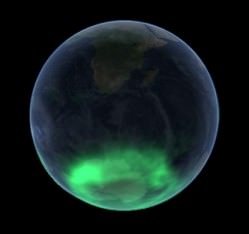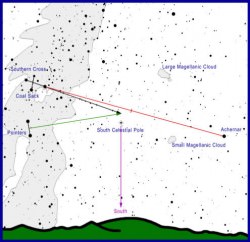Something that baffled me throughout my childhood, growing up in Australia, was the frequent references to the Man in the Moon, in children’s books and other popular media. I just couldn’t see it.
Only in my adult years have I put two and two together and realized that all those references were made by people from the Northern Hemisphere.
South of the equator we really are down under, even in astronomical terms. All the stuff you can see in the night sky around the celestial equator and the ecliptic we can see too, but it’s all upside down (or from our point of view, right side up).
So the lunar maria you see on the Moon’s surface, we can see too, but upside down none of it looks anything like a human face.
And Orion’s Belt? Nope, don’t get that either. What we see is an asterism we like to call ‘the Saucepan’ because what you see as a dagger hanging off a belt, we see as a handle rising from a pot.
We’ve also got our own down under Aurora Australis, although you’d have to climb a mountain in Tasmania, or even better catch an icebreaker to Antarctica, to see it.
climb a mountain in Tasmania, or even better catch an icebreaker to Antarctica, to see it.
But look, I’m envious. You’ve got a pole star, Polaris, which we never get to see. And you get a good view of the Andromeda Galaxy, which just barely peeks over our northern horizon around summer.
Down under, we have to use the Southern Cross to find the southern celestial pole. The Cross contains some of the southern sky’s brightest stars. During the winter months when it’s high in the sky, it’s generally the first group of stars to become visible after sunset, along with the nearby Pointer stars – which are actually Alpha and Beta Centauri.
The Southern Cross is kite-shaped and if you draw a line out from the kite’s long axis and another line out from between the Pointers, those two lines meet at the southern celestial pole. From there, just drop your hand straight down to the horizon and you are pointing due South. Cheaper than a compass.
We also have a couple of dwarf galaxies to look at, being the Large and Small Magellanic Clouds. OK, they are much smaller than Andromeda, but they are also a lot closer and hence appear much bigger. To the naked eye, they really do look like a couple of faint, wispy clouds.
For most southern sky observers, the Magellanic Clouds and the Southern Cross are circumpolar, slowly spinning around the southern celestial pole each night without ever setting.
You probably know that the story about how water spirals down the plug hole in opposite directions on either side of the equator is just urban myth. But it is the case that while stars in the Northern Hemisphere appear to spin slowly around Polaris in an anti-clockwise direction, all our stars spin around the southern celestial pole in a clockwise direction.
It’s true – fair dinkum.

I really need to say that the north hemisphere is up-side-down, not the southern one! 🙂
I always get a kick out of those maps of the world where south is pointing up. Looks like a whole different planet! =D
Thanks steve – enjoyed your article. There is sometimes an unintended ‘northern hemisphere bias’ in a lot of info.
Here in Australia a lot of our ‘knowledge’ was channelled through the UK now replaced by the USA.
The one that always got me was the Mercator projection of the world map which put the equator about 2/3 of the way down the map instead of 1/2 way – tends to ‘flatten’ continents like Africa, South America and Australia.
In Peter’s projection (which puts the equator 1/2 way down where it belongs) these countries are a lot longer.
The graphic of the man in the moon southern hemisphere is silly.
Just type “man in the moon southern hemisphere” in Google, ans lo and behold there is an article of the northern and southern hemisphere face. I.e. http://www.netaxs.com/~mhmyers/dnunder.html
Frankly, the southern one looks more like a face than the north!
See. Even kids learn this in school!
So why the question mark on the graphic?
The most despicable thing ever written on the southern hemisphere was A.E. Roy kids book called “The Stars”, where he says;
Prejudice clearly is ever rampant, even in the sky!
(Just look at the listing of the southern constellations in the three volume tome of Burnham’s Celestial Handbook. I.e.The constellation of Mensa on one lousy page. pg. 1173.
As for observing objects, anything north of ?30 degrees south declination is absolutely no interest to me. We need Burnham’s Celestial Handbook : Volume 4. – What he missed in the entire southern hemisphere of the sky!
… northerners. Who needs ’em!
My last post should read;
“As for observing objects, anything north of -30 degrees south declination…”
I notice that the comment I posted yesterday has still not found its way out of the moderation queue, thus depriving readers of vital cultural knowledge.
I guess UT must use the default WordPress setting that any comment is placed in the moderation queue if it contains two or more links. (On my own blog, I’ve set that number to four.)
Seriously – who could possibly think that the north has it over the south in terms of objects in the sky? S&T did an article on this a year or more ago, rating the best three objects in the sky and giving points for them in each major category of deep sky object, as well as a total overall rating for the category in question. The south trounced the north – by more than 2 to 1! The ONLY category in which the north just edged out the south was galaxies. For emission nebula, reflection nebula, planetary nebula, dark nebula, open clusters, globular clusters, double stars, etc etc, the south owns it!!
Come to Oz – we’ll show you some real sights to behold, from some real sites to behold – real dark sky, not the pale (literally) imitation that you guys get in the north!!
Some books on southern skies that I found most useful include Hartungs’ “Astronomical Objects for Southern Telescopes”, the Webb Society Deep-Sky Observers Handbook “Volume 7 – The Southern Sky” and “Exploring the Southern Sky”, a coffee table book using amazing images from the European Southern Observatory.
While all three are currently out of print IIRC, they are worth seeking out. All three were written before the rise of the internet and provide descriptions of objects based on visual or photographic observations. But being situated in the northern hemisphere, I’m sure I’ve missed other commendable works. Any other books on the southern skies I should check out?
At least Southerners see the Rabbit in the Moon better than we Northerners do.
The Aztecs (or the Mayans? Can’t remember) called the Moon ‘the 400 Rabbits”.